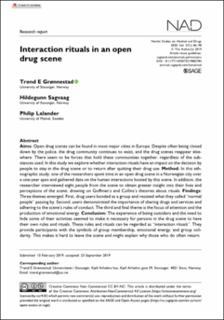| dc.contributor.author | Grønnestad, Trond Erik | |
| dc.contributor.author | Sagvaag, Hildegunn | |
| dc.contributor.author | Lalander, Philip | |
| dc.date.accessioned | 2020-05-15T11:53:31Z | |
| dc.date.available | 2020-05-15T11:53:31Z | |
| dc.date.created | 2020-01-07T15:34:39Z | |
| dc.date.issued | 2019-12 | |
| dc.identifier.citation | Grønnestad, T.E., Sagvaag, H., Lalander, P. (2019) Interaction rituals in an open drug scene. Nordic Studies on Alcohol and Drugs, 37(1) | en_US |
| dc.identifier.issn | 1455-0725 | |
| dc.identifier.uri | https://hdl.handle.net/11250/2654643 | |
| dc.description.abstract | Aims:
Open drug scenes can be found in most major cities in Europe. Despite often being closed down by the police, the drug community continues to exist, and the drug scenes reappear elsewhere. There seem to be forces that hold these communities together, regardless of the substances used. In this study we explore whether interaction rituals have an impact on the decision by people to stay in the drug scene or to return after quitting their drug use.
Method:
In this ethnographic study, one of the researchers spent time in an open drug scene in a Norwegian city over a one-year span and gathered data on the human interactions hosted by this scene. In addition, the researcher interviewed eight people from the scene to obtain greater insight into their lives and perceptions of the scene, drawing on Goffman’s and Collins’s theories about rituals.
Findings:
Three themes emerged. First, drug users bonded as a group and resisted what they called “normal people” passing by. Second, users demonstrated the importance of sharing drugs and services and adhering to the scene’s rules of conduct. The third and final theme is the focus of attention and the production of emotional energy.
Conclusion:
The experience of being outsiders and the need to hide some of their activities seemed to make it necessary for persons in the drug scene to have their own rules and rituals. These rules and rituals can be regarded as “interaction rituals”. They provide participants with the symbols of group membership, emotional energy, and group solidarity. This makes it hard to leave the scene and might explain why those who do often return. | en_US |
| dc.language.iso | eng | en_US |
| dc.publisher | SAGE Publishing | en_US |
| dc.rights | Navngivelse-Ikkekommersiell 4.0 Internasjonal | * |
| dc.rights.uri | http://creativecommons.org/licenses/by-nc/4.0/deed.no | * |
| dc.subject | etnografi | en_US |
| dc.subject | narkotika | en_US |
| dc.subject | rusmisbruk | en_US |
| dc.title | Interaction rituals in an open drug scene | en_US |
| dc.type | Peer reviewed | en_US |
| dc.type | Journal article | en_US |
| dc.description.version | publishedVersion | en_US |
| dc.rights.holder | Copyright the author(s) 2019 | en_US |
| dc.subject.nsi | VDP::Samfunnsvitenskap: 200 | en_US |
| dc.subject.nsi | VDP::Medisinske Fag: 700::Helsefag: 800 | en_US |
| dc.source.pagenumber | 13 | en_US |
| dc.source.volume | 37 | en_US |
| dc.source.journal | Nordic Studies on Alcohol and Drugs | en_US |
| dc.source.issue | 1 | en_US |
| dc.identifier.doi | 10.1177/1455072519882784 | |
| dc.identifier.cristin | 1767893 | |
| dc.relation.project | Universitetet i Stavanger: IN-11551 | en_US |
| cristin.ispublished | true | |
| cristin.fulltext | original | |
| cristin.qualitycode | 1 | |

